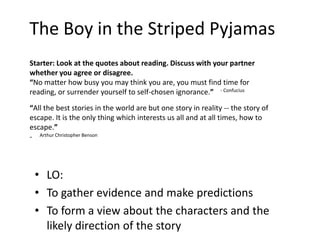
The Boy in the Striped pyjamas
- 1. The Boy in the Striped Pyjamas • LO: • To gather evidence and make predictions • To form a view about the characters and the likely direction of the story Starter: Look at the quotes about reading. Discuss with your partner whether you agree or disagree. “No matter how busy you may think you are, you must find time for reading, or surrender yourself to self-chosen ignorance.” - Confucius “All the best stories in the world are but one story in reality -- the story of escape. It is the only thing which interests us all and at all times, how to escape.” - Arthur Christopher Benson
- 2. The Boy in the Striped Pyjamas LO: To gather evidence and make predictions To form a view about the characters and the likely direction of the story
- 3. Book cover and blurb • If you already know the story, keep quiet and don’t reveal anything! • What do the cover and blurb suggest about the story? • What questions come to mind about the pictures? • ‘This isn’t a book for nine-year-olds.’ What does this suggest?
- 4. First impressions • When and where is the book set? • How old is Bruno? • Where does he live and with whom? • What impression do we get of his character?
- 5. OPENING AND PREDICTIONS: BUILDING A CASE We are going to focus on John Boyne’s use of intrigue and mystery in his first two chapters. You will have noticed that he often only hints at certain details about Bruno’s changing situation, without saying outright what is happening. Working with a partner, try to answer these three crucial questions: • 1 Why have Bruno’s family suddenly moved house? • 2 Who are the Fury and the beautiful blonde woman? • 3 What does Father’s new job appear to be? You’ll have to be a real reading detective, and focus on gathering hints and clues. Fill in your evidence, clues and conclusions.
- 6. Follow this structure • 1 Why have Bruno’s family suddenly moved house? • Evidence and clues: ……………………………..…………………………………………………… • Page number: …………………………………………………………………………………………. • Our conclusion: ………………………………………………………………………………………..
- 7. Prediction • What do you think will happen next? • What do you think the story is about?
- 8. Lesson2: Learning Outcome • Understand the use of the term ‘writer’s purpose’ • Distinguish between a writer’s viewpoint and that of the characters • Use clues from the text to develop a picture of the setting of the book
- 9. Chapters 3 and 4 • Read chapters 3 and 4. • Write down questions about both chapters.
- 10. What is the writer trying to achieve? Look at the following hints and clues. Think about why John Boyne uses these particular words and phrases to describe people and places. • A hint from the writer… Gretel has a few titles, such as ‘The Hopeless Case’ and ‘Trouble From Day One’ (page 21). Why do you think John Boyne has Bruno call her this?
- 11. Another little clue… • Gretel calls their new home ‘Out-With’ (page 24). Why do you think John Boyne chooses to have Gretel call the place this? What does the name suggest to you?
- 12. Hinting through description… • The writer describes the house as ‘hollow’ and says ‘it might collapse around their ears’ on page 26. What impression does this give of ‘Out- With’, and why do you think John Boyne uses this particular description?
- 13. Reading between the lines • Active reading strategy: reading between the lines or making inferences. • This involves investigating the things a writer hints at, without saying them in an outright way. p. 36 • Which words and phrases hint at danger? How do they do this?
- 14. HINTS OF DANGER In a pair, make notes on the following extract, showing which words and phrases hint at danger and how they achieve this. • ‘Look over there,’ said Bruno, and Gretel followed the direction of the finger he was pointing and saw, emerging from a hut in the distance, a group of children huddled together and being shouted at by a group of soldiers. The more they were shouted at, the closer they huddled together, but then one of the soldiers lunged towards them and they separated and seemed to do what he wanted them to do all along, which was to stand in a single line. When they did, the soldiers all started to laugh and applaud them. • p. 37
- 15. Pyjamas • What do you associate with pyjamas? • Write down words or phrases that come to your mind.
- 16. Homework: LO: • To select and retrieve information from a range of sources about the Holocaust
- 17. Copy and fill in the gaps with skimming or scanning. • _________ means reading only key words quickly, to get an overview of a text. • __________ means looking quickly over each word of a text looking for a specific word or phrase, e.g. final solution.
- 18. Tips for researching! • Key words may trigger information you do not need, so you may need to skim to look for other words related to your search, e.g. Nazis. • Coloured and underlined words on the screen are usually hyperlinked to another website. • There’s no need to read all the text on the screen – use skimming and scanning skills.
- 19. Feedback How do you feel about what you have learned today?
- 20. Plenary Discuss 3 things you have learned in today’s lesson with your partner.
